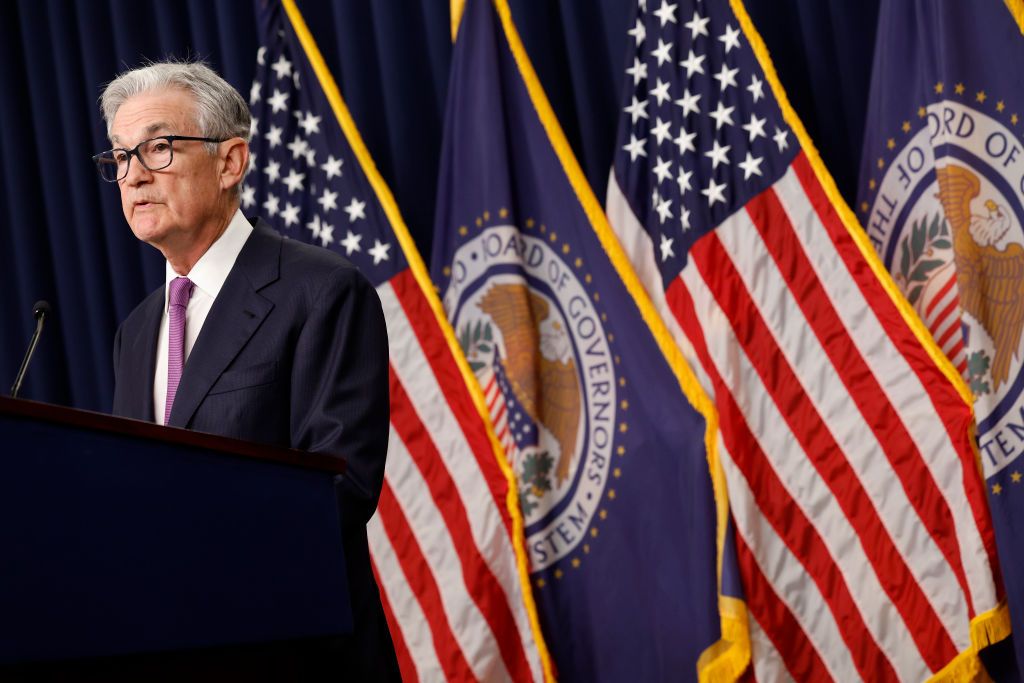High interest rates may soon get higher. CNN reported that JPMorgan Chase CEO Jamie Dimon sent a “stark warning” to Wall Street on Monday that it is possible the Federal Reserve will raise the benchmark rate all the way to 7% — even though most analysts think it will top out under 6%. If his “contrarian” prediction is correct, “you’re going to see a lot of people struggling," Dimon said.
But the new era of high interest rates is already rippling through the economy and government.
The effects are being felt in the housing market: CNBC reported that mortgage demand fell 6% during the last week of September because “mortgage rates just continue to climb higher.” Rate hikes are affecting car buyers: The average monthly payment on a new car is $736 — up $33 from a year ago, per Axios. And they’re being felt in Hollywood: Financial Times noted that entertainment companies are putting an end to the “golden era of cheap streaming” because rates are making TV and movie production more expensive. Expect fewer new shows and higher streaming subscription costs.
Washington isn’t immune to the effects, either. The federal government was able to swallow rising deficits over the last 15 years, Eric Levitz argued in Intelligencer, because it could borrow money cheaply. Now the yield on a 10-year bond is at 4.8%, “its highest level since 2007.” If the rate stays that high, “the implications for the nation’s finances will be profound.” If federal borrowing continues and rates don’t come down, “interest payment will come to consume more than half of federal tax revenue by 2050.”
‘Higher for longer’
“Forget the shutdown,” The Economist editorialized. America’s “real fiscal worry” is rising bond costs linked to the Federal Reserve’s decision to keep interest rates “higher for longer” as it tries to rein in inflation. Right now, the Feds spend 2.5% of the country’s gross domestic product servicing the national debt. By 2030, that number will be 3.2%, “equaling an all-time high and more than the cost of defense.” And that might even be a low estimate. It’s clear that American politicians cannot “continue to act as if deficits do not matter.”
“Rising interest rates mean deficits finally matter,” Greg Ip added at The Wall Street Journal. The now-dead era of ultra-low interest rates meant that “we had a blissful 25 years of not having to worry about this problem,” one analyst said. But it’s tough to see who might solve that problem: Former President Donald Trump and President Biden “have signed deficit-busting legislation” and nobody seems interested in either tax hikes or cutting Medicare and Social Security.
Don’t panic, Louise Sheiner wrote for The Brookings Institution. Yes, interest rates are high now — a big reason the deficit has increased — but “it is too soon to know whether the recent increases will persist, and if so, why.” If rates do come back down, or if the GDP gets an unexpected boost, the crisis will be averted. For now “it is much too soon to tell.”
‘The Romans had it worse’
Bank of America is taking the really long view on interest rates, Insider reported. The bank charted interest rates over 5,000 years of human civilization and found that while interest rates are relatively high now — compared to recent history — “the Romans had it worse.” The analysis was a bit tongue-in-cheek, however. “Investors can probably take the chart with a grain of salt.”
“So is the low-interest era really over?” asked The New York Times’ Paul Krugman. He doesn’t think so — and points to Japan as the model. That country has had both low population growth and low interest rates for a long time, and America is entering its own low-population growth phase. “Why shouldn’t we expect interest rates to go back to prepandemic levels once the Fed is done fighting inflation?”
Maybe there’s no reason for the Fed to raise rates further. The data suggests “inflation is falling,” Texas Tech University economist Alexander William Salter argued at The Hill, concluding that “fighting inflation is good, but causing needless economic pain isn’t.”
Historically, 7% would be just slightly above average interest rates. What was not normal was the near zero percent interest we had for a few years.
Unless I’m missing something, that graph indicates the rate was consistently below 7% - often significantly - from ~1860-1970. How the heck do you define slightly?
Question: why is our government’s only method of controlling inflation essentially just giving more money to the banks? We don’t have other tools at our disposal beyond making rich bastards even richer?
why is our government’s only method of controlling inflation essentially just giving more money to the banks?
I take it from your statement that you are saying you believe the that 7% in the article is money a retail borrow (like you or me) pays to the bank which they profit from. Do you believe that is the case? It doesn’t work that way. An overly simplistic explanation is that 7% is interest the bank itself pays to borrow the money from the Federal Reserve.
Now you’re asking why the bank needs to borrow money from the Federal Reserve? Here’s yet another simplistic explanation:
A bank takes in money from depositors (your checking and savings accounts, certificates of deposit, etc). It pays a very small amount of interest (usually between .01% in most cases and maybe as high as 4% in rare cases) to depositors. So the bank needs to profit if it is a business. One huge area is lending. It loans your money (and everyone else’s) out to people buying houses, cars, and companies borrowing for startups or expansion. They charge various interest rates on these loans and I think THIS is the interest you’re thinking of from the article. The article’s interest is different.
Banks aren’t allowed (anymore) to loan out every dollar they have to try to make the most profit. They’re required by laws written by Congress to keep a pretty large chunk in cash (not paper per se) on the books. This means if you and 1000 of your best friends come to the bank and demand all your money, you’ll likely get it even though there’s lots of loans out. If the bank has loaned out too much then they won’t have enough cash to meet the regulations.
This is where the Federal Reserve’s benchmark rate comes in from the article.
I bank can, overnight, borrow millions of dollars from the Federal Reserve to make sure it has cash on the books, then returns that money in the morning. The 7% from the article interest THE BANK has to pay to the Federal Reserve for the overnight borrowing. In the morning the bank starts getting regular deposits again, so it doesn’t need the Federal Reserve’s money for the day. At night, they have to pay out their expenses and pay interest to their depositors so they may be short again. So the bank AGAIN borrows millions overnight and pays interest to the Federal Reserve. This is the banking business in short.
Source: If you want more info here’s a better and more complicated write up
I hope that helps.
Great answer, thanks for taking the time to write it out, my misunderstanding is cleared up
You explained how the system works, but not why it works that way.
“why the banking system works this way” wasn’t the question, but I touched on part of that answer in my prior post.
A little bit more of an answer (but still far too simplistic) is that a series of laws was repealed (primary Glass-Steagall Act of 1933 ) allowing banks to take deposits and gamble with customer deposit money. This lead to banks not keeping enough money in the bank because they wanted more profits from the gambling. Part of that gambling lead to the fallout of the Financial Crisis in 2008. In a response to that new legislation was made ( primarily the Dodd-Frank Act) that forced banks to keep more money in the bank and be able to dispense it to depositors. You may have heard headlines of “banks being stress tested”. Thats part of Dodd-Frank requirements. The stress tests run scenarios with the banks numbers against hypothetical situations. If the bank’s processes and accounts don’t pass, the amount of cash they need to keep in the bank goes up. This is one mechanism to help insure your money will be there in the bank the way you expect it to be.
Now, lawmakers could do even better by putting most Glass-Steagall Act back in place with all its protections to depositors, but there’s too much money and corporate interest to do that.
Again, you’re explaining the way the system currently works, but not why. Why do we have a federal reserve system?
I’m not sure if you’re asking because you don’t know or because you’re hoping @partial_accumen will provide an educational answer, but a quick Google search provides the answer you seek:
https://www.federalreserve.gov/faqs/about_12594.htm
The Federal Reserve System, often referred to as the Federal Reserve or simply “the Fed,” is the central bank of the United States. It was created by the Congress to provide the nation with a safer, more flexible, and more stable monetary and financial system.
Before that, throughout the 1870s and on, the American economy was plagued with “boom and bust” economic cycles that regularly wiped out the investments and savings of the average citizen. A lot of the financial regulations we see are a response to that addiction to gambling that banks and investors seem to crave. Our capitalist system requires us to tolerate financial gambling (aka “stock market investment”) but not at the cost of pinning our financial security on it. We’ve seen too many busts to allow it to go unregulated. The Federal Reserve is designed to act as a buffer against that, but it is not the whole solution. It’s merely a front line defense against economic chaos.
I’m not buying the idea that we need to surrender control of our monetary system to privately-owned banks in order to have a stable system.
Well you’re in luck! The Federal Reserve isn’t a privately-owned bank. Its part of the Federal government.
Correct. That’s why the Fed was created, because without that oversight, private banks and business interests constantly destabilize the economy in their bid for supremacy.
This guy banks





